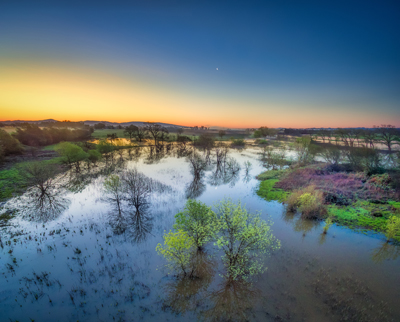The Convention on Wetlands and Ramsar Designation
The Convention on Wetlands is the intergovernmental treaty that provides the framework for the conservation and wise use of wetlands and their resources. The Convention was adopted in the Iranian city of Ramsar in 1971 and came into force in 1975. Since then, almost 90% of UN member states, from all the world’s geographic regions, have acceded to become “Contracting Parties”. Originating from concerns over protecting migratory waterfowl that depend on wetlands across countries, the Ramsar Convention has expanded its focus to highlight the diverse ecosystem services offered by wetlands, such as flood control, species habitat, and recreational opportunities. Rather than using regulations, the Convention raises public awareness about the vital role of wetlands in global ecology.
About Ramsar
Since 1975, the Ramsar Convention has designated wetlands worldwide to emphasize their importance and the ecosystem services they provide. At the time of joining the Convention, each Contracting Party must designate at least one wetland site within their territory for inclusion in the List of Wetlands of International Importance (the "Ramsar List"). These "Ramsar Sites" acquire a new national and international status. They are recognized as being of significant value not only for the country or the countries in which they are located, but for humanity as a whole.
There are currently over 2,400 Ramsar Sites around the world. They cover over 2.5 million square kilometres, an area larger than Mexico. Parties continue to designate wetlands for inclusion in the List. They select suitable wetlands for designation by referring to the Criteria for identifying Wetlands of International Importance. The Convention has provided guidance to Contracting Parties on the management of Ramsar Sites, in addition to its guidance on the wise use of all wetlands. The inclusion of a wetland in the List embodies the government’s commitment to take the steps necessary to ensure that its ecological character is maintained. The Convention includes various measures to respond to threats to the ecological character of Sites.
Designation
Image: Laguna Moon by Steve GibbsThe Laguna Foundation spearheaded a coalition of private and public landowners in a lengthy effort to petition the Ramsar Convention to recognize the Laguna de Santa Rosa Wetland Complex. On February 2, 2011, World Wetlands Day, the Convention officially designated the Laguna de Santa Rosa Wetland Complex as a Wetland of International Importance. The Laguna de Santa Rosa Wetland Complex became the 30th site in the United States to receive this distinction.
This recognition is particularly significant for the Laguna and surrounding Santa Rosa Plain Wetland Complex due to its biodiversity, including rare and endangered plant and animal species. The region is also noted as one of the world's few diverse hotspots and is renowned for its unique vernal pool environments. This designation underscores the global significance of our local environment.
Learn more about the International Convention on Wetlands and Ramsar Designations at ramsar.org.
[ top ]
. Banner Image by Lucy Aaron

